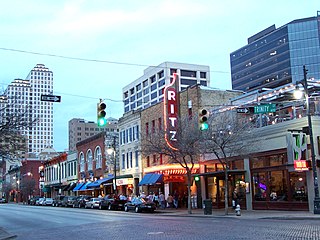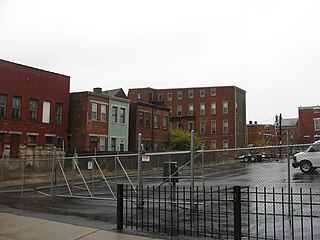
Sixth Street is a historic street and entertainment district in Austin, Texas, located within the city's urban core in downtown Austin. Sixth Street was formerly named Pecan Street under Austin's older naming convention, which had east–west streets named after trees and north–south streets named after Texas rivers.

The Claremont Riding Academy, originally Claremont Stables, 175 West 89th Street, between Columbus and Amsterdam Avenues on Manhattan's Upper West Side, was designed by Frank A. Rooke and built in 1892. Closed in 2007, Claremont was the oldest continuously operated equestrian stable in New York City and the last public stable in Manhattan. The building was listed on the National Register of Historic Places in 1980 and designated a New York City Landmark in 1990. Since 2010, it has belonged to the Stephen Gaynor School.

Fire Station No. 9 was located at 2 South 14th Street in Kansas City, Kansas. Designed by William E. Harris, it was declared a Kansas City, Kansas Historic Landmark on June 16, 1983. The fire station was placed on the Register of Historic Kansas Places on July 3, 1979, and the National Register of Historic Places on September 5, 1985. It has also been known as the Prescott Neighborhood Center. The building is currently owned and occupied by Community Housing of Wyandotte County. The new Fire Station No. 9 is located at 1100 Central Ave. in Kansas City, Kansas.

Police Station Five was a historic police station in the West End neighborhood of Cincinnati, Ohio. Constructed in the 1890s to serve both regular police and the city's patrol service, it was named a historic site in the late twentieth century, but historic designation was unable to save it from destruction.

The Historic Track is a half-mile harness racing track in Goshen, New York. It was opened in 1838 and has been in operation ever since, the oldest continuously operated horse racing track in North America.

Grand Canyon Village Historic District comprises the historic center of Grand Canyon Village, on the South Rim of the Grand Canyon in Grand Canyon National Park, Arizona. The district includes numerous landmark park structures, many of which are National Historic Landmarks themselves, or are listed on the National Register of Historic Places. The town design as a whole is also significant for its attention to integration with the Grand Canyon landscape, its incorporation of National Park Service Rustic design elements, and for the idiosyncratic design of park concessioner structures such as the El Tovar Hotel.

The Old Livery Stable in Fountain, Colorado is a historic stable which was built in 1893 as part of a small hotel complex. It housed horses of hotel guests. With the rise of automobiles such use ended and the stable decayed. The hotel was damaged in a fire in the 1940s, then partially repaired to serve as a rooming house, then demolished to make way for new buildings; only the stable remains.

The City Stable and Garage is a historic public works building at 74 Elliot Street in Newton, Massachusetts. The 1.5-story brick building was built in 1926–27, and represents a transitional period between the use of horse-drawn equipment and the advent of combustion-powered vehicles. Built on a hillside, it has a fully exposed basement with four garage bays, while its main level originally housed 26 horse stalls. It was designed, however, so that the main floor could be converted to automotive use when horses were no longer needed. The building is also a fine example of Flemish Revival design, with stepped gable ends.

C. W. Miller Livery Stable is a historic multi-story livery stable located at Buffalo in Erie County, New York. It is a six-story, rectangular masonry building 65 feet wide and 236 feet deep, built between 1892 and 1894. As horses were phased out and automobiles became more common, it was converted for use as a parking garage.

The O.K. Corral was a livery and horse corral from 1879 to about 1888 in the mining boomtown of Tombstone, Arizona Territory, in the southwestern United States near the border with Mexico.

The El Tovar Stables at the south rim of the Grand Canyon were built about 1904, at the same time the nearby El Tovar Hotel was built, to house the animals used in general transportation around the park. Collectively called the "transportation department" in the early 20th century, the three structures comprised a horse barn or stable, a mule barn and a blacksmith shop.

The Lohnam Funeral Home and Livery Stable are located in Milwaukee, Wisconsin. In 1988, the site was added to the National Register of Historic Places. According to its application, it is an "example of a 19th century commercial livery stable in the day".

The Chelsea Commercial Historic District is a historic district located along both sides of Main Street from Orchard to North Street in Chelsea, Michigan; the district also includes the adjacent 100 blocks of Jackson, East Middle, and West Middle Streets, as well as structures on Park, East, and Orchard Streets. It was listed on the National Register of Historic Places in 2011.

Torbert Street Livery Stables, also known as Hercules Powder Company Printing Department, Charles Printing Co., Wilmington Motorcycle Club, Cann Bros & Kindig Printers, and Barclay Bros Printing, is a historic livery stable located at Wilmington, New Castle County, Delaware. It was built in 1887, and consists of two separately-built, two-story livery stables, joined and expanded through additions and internal alterations. A connecting hyphen was built during or after 1946. Both structures are constructed of brick and have gable roofs. The interior consists of large open spaces supported by cast iron columns and historic wood beams reinforced with iron rods. Also on the property is a contributing cast iron street lamp. The buildings housed livery stables into the early 20th century, after which they were occupied as a cabinet-making shop, a cycle club, auto garages, commercial and corporate printing facilities, and a warehouse.

Hansen's Annex is a historic house on Main Street in Center Sandwich, New Hampshire, United States. Built about 1839, it is one of a small number of Greek Revival buildings to survive, out of many that once graced the town. It has seen use as a single-family residence, tavern, and boarding house. It was listed on the National Register of Historic Places, and included in the Center Sandwich Historic District, in 1983.

The Joseph and Daniel Marsh House is a historic farmstead at 1119 Quechee Main Street, just outside the village Quechee in Hartford, Vermont. Built in 1793, it was the home of Joseph Marsh, one of Hartford's early settlers and the first Lieutenant Governor of Vermont. Now the Quechee Inn, the property was listed on the National Register of Historic Places in 1998.
The Duplex at 73-75 Sherman Street is a historic multiunit residential building in Burlington, Vermont. Built about 1912 as a livery stable, it was adapted into a residential duplex in 1927. It is a good local example of vernacular Colonial Revival architecture, built as worker housing in the growing city. It was listed on the National Register of Historic Places in 2013.

The Miller-Walker House was a single-family home located at 117 McKay Street in Saline, Michigan. It was listed on the National Register of Historic Places in 1985. The house is missing and is presumed to have been demolished some time after 1985.

The William Prindle Livery Stable is a farmer stable located at 323 West Michigan Avenue in Marshall, Michigan. It was listed on the National Register of Historic Places in 1982. It currently serves as the city hall for Marshall.

The R.H. Cowan Livery Stable, at 220 Maxwell Ave. in Springer, New Mexico, was built in 1883. It was listed on the National Register of Historic Places in 1979.






















